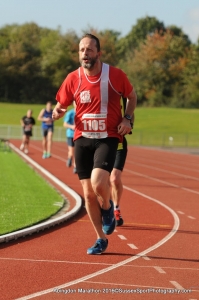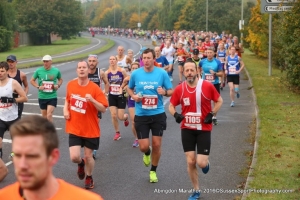How to join our Tuesday club runs - Read More
Dan’s Journey from Abingdon to London. Part 1.
During the week before I ran October’s Abingdon marathon, I was lucky enough to get one of the HPH club places at the London marathon in April 2017. I am chuffed to bits about this and am really looking forward to the campaign and to representing HPH at VLM ’17. Before then I’ll try to blog a few times and, of course, after the big race itself. Once this weekend’s Abbey Dash is out of the way, I will sit down and formulate a plan … and central to that plan will be various things I’ve learned about myself during 2016.
Background: A brief bit of background for context. I started running in summer 2008, aged 42 … the familiar mid-life situation of being so busy raising 4 children and working that you fail to notice you’ve crept up to a BMI comfortably into the “overweight” range (quite an achievement for someone who was once a lanky kid). Fitness levels were appalling but 2 months later I ran my first parkrun (or HPTT as it was then) in 26:xx and, as the weight came down a bit over the next 2 months I got that down to 23:xx, before breaking 48 at the 2008 Abbey Dash. I knew this was something I was now going to do for life. My “Golden Era” started 2 years later when I finally broke 40 minutes at Abbey Dash and then went on to set PBs at all distances during the following year. I’ve not yet regained those heights and, now aged 50, accept (begrudgingly) that those race times are getting more difficult to beat/maintain … but I’ve set myself 70% WAVA as a minimum standard to maintain as the greyness sets in. This year I gave up my work parking permit and became a full-time bike commuter. Although only 10-11 miles per day, it has meant that I tend to only run 4 times a week now (extra fatigue … and there is a limit to the number of showers I can be bothered with). I have compensated by doing more speed-work and tempo sessions and in fact my times this year have been pretty decent (including a WAVA PB at parkrun and a 1 mile proper PB). The cycling has also meant it’s easier to visit the dark side occasionally by sneaking in the odd triathlon – doing the ITU Olympic distance tri in June with the HPH crew just after my 50th birthday was a 2016 highlight.
Marathons. However, there has always been one big fly in my Vaseline… The Marathon! I just can’t get it right. I simply cannot convert my 5K-HM times to 26.2! I’ve done 7 now and the best WAVA to date has been 66% … 7% below “best”, which translates into 15-20 minutes behind where my 5K-HM times suggest I should be. This lack of endurance has meant that I’ve faced some very nasty demons in the final 10K of several marathons! So why am I so rubbish at marathons? I’m quite partial to training books, theories, running forums, etc., and consequently I’ve diligently followed a few different plans along the way (Hadd, P&D, etc.), and played with various fuelling and tapering strategies. But nothing has made it remotely likely that I will be able to run 26.2 miles at my predicted “marathon pace” (MP) of about 7:30 min/mile… I’ve never even managed to maintain 8 min/mile!
Metabolic Conditioning. So this summer I decided to try a new approach – one based on metabolic conditioning. This was based on the hypothesis that my inability to run a marathon was down to my inappropriate fuel usage rather than my “fitness”. We use two fuels when we run – glucose and fat. The faster you run, the greater the percentage of glucose used. Although we can only store a limited amount of glucose (in the form of glycogen) when properly fuelled/fed, this is usually sufficient to run up to half marathon distance. No problem – training for these distances is all about teaching the muscles to grab and use oxygen. However, a marathon gets to the intriguing distance which is a little way beyond where most of us will run out of stored glucose (assuming running at MP … if you run slower, then you can run further on stored carbs). To get to the end of 26.2 in good shape we need to supplement our stored glucose by taking on gels/energy drinks (tricky as the gut doesn’t like absorbing nutrients during exercise), and/or by training sufficiently so that we are able to burn more fat and less glucose when running at MP (we all have more than enough fat to keep us going indefinitely). Long runs and LT sessions are supposed to help with the latter but clearly this hadn’t worked for me in the past. I concluded that I am just way too carb-dependent. So, what I decided to do differently this summer was to try to train my fat-burning capacity by doing my long runs “on empty”. In the past, I’d typically do my long runs early on a Sunday morning, having had Saturday as a rest day and having fuelled rather well (as was often the case at the weekend). Although I’d skip breakfast on those Sunday mornings, and hence perhaps had reduced liver glycogen, it was very likely that my muscle glycogen levels were still topped up. So in hindsight, my long runs were typically done in a well fuelled state. Good idea if racing but probably not a good idea when endurance training. Carb-free running was calling me!
Now, as it happens, I’d already cut back heavily on eating carbohydrates at the start of this year (I’m now of the view that refined carbs cause insulin resistance which underlies many of the modern metabolic disorders, which can’t be dodged just by being active… but that’s another story). This summer, I strategically took on carbs only before races and hard sessions but made sure that I had a few days without eating carbs, before then doing a medium long run (commute home on a Tuesday) and then doing my proper long run early on Wednesday morning (back to work). The idea was that the cumulative fatigue and the empty carb tank would put me in a place close to what you might experience in the second half of a marathon and consequently train the fat-burning metabolic systems I’d need at that stage. It did feel a bit like the end of a marathon … and it took a bit of getting used to … but I did begin to gain the ability to run at MP during the latter stages of the LSR. Doubling up meant that the longer 2nd run was shorter than my previous campaign long runs … I’ve done the standard “5 x 20+” in the past but this time I only built up to 3 x 16 miles and 1 x 18 miles (preceded by 8-10 miles the night before) before doing a final fuelled 20 miler (with the last 5 at MP) 3 weeks before race day. This was way down on previous long run mileage but they were always tough runs and so I hoped/prayed they were ticking the right boxes. Nevertheless, coupled with the reduced mileage caused by the bike-commuting, I was a bit worried about what might happen once I got to 20 miles (i.e. “half way”).
The Race. Abingdon is a long way from Leeds but it’s a well organised race on a flat course. And I was double booked for Chester. And I hadn’t entered York in time. So Abingdon it was, meaning 180 miles of driving was required on Saturday night. I got there after 9 pm and got a reasonable night’s sleep at a local B&B, was up early for white toast and honey (x4) in the morning, and then off to the start line. I was the VERY last person in the toilet queue due to a last minute decision (well it’s a long race, you can’t be too careful) … but I made it to the start line with seconds to spare. Plan was to run at about 8 min/mile which would get me in just under 3:30 … however, my PB is 3:32:43 and was set in mara#2 in 2011 in my “Golden Era”, when I ran a sub-40 10K and 90 min HM (times I cannot get close to at the moment). Since that PB I’d managed another 4 marathons in 2013-14, all in the 3:35-3:39 range. So 8 min/mile was certainly ambitious, especially given the reduced mileage.
Mile 1
Well, yes indeed, it did turn out to be ambitious … but not excessively so. I actually held 7:56/m all the way to 22 miles (10 in 1:19:20; 20 in 2:38:42, 22 in 2:54:26 … metronomic by my standards) but then quite quickly the fatigue set in and the final 4.2 miles averaged at 8:43/m. However, this felt different to the closing stages of previous marathons … it was much more of a normal “fatigue” feel compared with “The Wall” … and I was even able to lift the pace significantly for the final 400m around the track. I managed 3:31:02 in the end, which is a PB, and over 7 min faster than Abingdon 2013.

Mile 26.1
Reflection. I think I just needed more mileage in my legs … 31 miles per week average over 16 weeks is never going to cut it for an optimal marathon, even with modest cycling supplementation! But it wasn’t far off being a success … happy to PB (it’s rare these days) but disappointed not to break 3:30 … and still bemused that I’m so far away from where I should be (3:15-3:20?). But I think the low-carb approach to my long runs was really good for me … maybe I just need to give myself a lot more time to metabolically adapt, and also combine it with higher mileage. Then I might yet crack the code.
So London 2017 training begins soon. Breaking 3:30 is a minimum target. More to come…
Dan Donnelly
